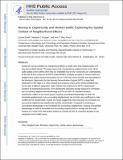| dc.contributor.author | Graif, Corina | |
| dc.contributor.author | Arcaya, Mariana C | |
| dc.contributor.author | Diez Roux, Ana V | |
| dc.date.accessioned | 2021-10-27T19:57:15Z | |
| dc.date.available | 2021-10-27T19:57:15Z | |
| dc.date.issued | 2016 | |
| dc.identifier.uri | https://hdl.handle.net/1721.1/133930 | |
| dc.description.abstract | © 2016 Elsevier Ltd. Studies of housing mobility and neighborhood effects on health often treat neighborhoods as if they were isolated islands. This paper argues that conceptualizing neighborhoods as part of the wider spatial context within which they are embedded may be key in advancing our understanding of the role of local context in the life of urban dwellers. Analyses are based on mental health and neighborhood context measurements taken on over 3000 low-income families who participated in the Moving to Opportunity for Fair Housing Demonstration Program (MTO), a large field experiment in five major U.S. cities. Results from analyses of two survey waves combined with Census data at different geographic scales indicate that assignment to MTO's experimental condition of neighborhood poverty <10% significantly decreased average exposure to immediate and surrounding neighborhood disadvantage by 97% and 59% of a standard deviation, respectively, relative to the control group. Escaping concentrated disadvantage in either the immediate neighborhood or the surrounding neighborhood, but not both, was insufficient to make a difference for mental health. Instead, the results suggest that improving both the immediate and surrounding neighborhoods significantly benefits mental health. Compared to remaining in concentrated disadvantage in the immediate and surrounding neighborhoods, escaping concentrated disadvantage in both the immediate and surrounding neighborhoods (on average over the study duration) as a result of the intervention predicts an increase of 25% of a standard deviation in the composite mental health scores. | |
| dc.language.iso | en | |
| dc.publisher | Elsevier BV | |
| dc.relation.isversionof | 10.1016/J.SOCSCIMED.2016.05.036 | |
| dc.rights | Creative Commons Attribution-NonCommercial-NoDerivs License | |
| dc.rights.uri | http://creativecommons.org/licenses/by-nc-nd/4.0/ | |
| dc.source | PMC | |
| dc.title | Moving to opportunity and mental health: Exploring the spatial context of neighborhood effects | |
| dc.type | Article | |
| dc.contributor.department | Massachusetts Institute of Technology. Department of Urban Studies and Planning | |
| dc.relation.journal | Social Science and Medicine | |
| dc.eprint.version | Author's final manuscript | |
| dc.type.uri | http://purl.org/eprint/type/JournalArticle | |
| eprint.status | http://purl.org/eprint/status/PeerReviewed | |
| dc.date.updated | 2019-09-18T12:29:55Z | |
| dspace.orderedauthors | Graif, C; Arcaya, MC; Diez Roux, AV | |
| dspace.date.submission | 2019-09-18T12:29:56Z | |
| mit.journal.volume | 162 | |
| mit.metadata.status | Authority Work and Publication Information Needed | |
